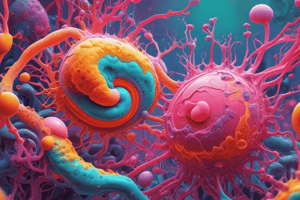Podcast
Questions and Answers
What is the main role of negative feedback loops in maintaining homeostasis?
What is the main role of negative feedback loops in maintaining homeostasis?
- To shut down pathways once a stable state is achieved (correct)
- To initiate new metabolic pathways
- To enhance fluctuations in internal conditions
- To cause permanent changes in cell function
Which of the following processes is NOT an example of homeostasis?
Which of the following processes is NOT an example of homeostasis?
- Increase in heart rate during exercise
- Regulation of external temperature (correct)
- Regulation of water and salt balance
- Blood pressure regulation
Which hormone is responsible for lowering blood glucose levels?
Which hormone is responsible for lowering blood glucose levels?
- Adrenaline
- Cortisol
- Glucagon
- Insulin (correct)
Why is the cell membrane crucial for maintaining cellular homeostasis?
Why is the cell membrane crucial for maintaining cellular homeostasis?
Which mechanism is activated when the human body temperature rises above the optimal level?
Which mechanism is activated when the human body temperature rises above the optimal level?
What occurs in cells when blood glucose levels fall too low?
What occurs in cells when blood glucose levels fall too low?
In the absence of insulin production, which condition is likely to develop?
In the absence of insulin production, which condition is likely to develop?
What triggers the release of insulin in the body?
What triggers the release of insulin in the body?
What is the primary function of cholesterol within the cell membrane?
What is the primary function of cholesterol within the cell membrane?
How does the phospholipid bilayer structure contribute to its function in homeostasis?
How does the phospholipid bilayer structure contribute to its function in homeostasis?
What role do aquaporins play in the cell membrane?
What role do aquaporins play in the cell membrane?
Why are ion channels that are gated by neurotransmitters important in the nervous system?
Why are ion channels that are gated by neurotransmitters important in the nervous system?
How is active transport involved in maintaining ion gradients in cells?
How is active transport involved in maintaining ion gradients in cells?
What is the result of osmosis in terms of solute concentration in cells?
What is the result of osmosis in terms of solute concentration in cells?
Which of the following is a consequence of maintaining a high concentration of potassium ions inside the cell?
Which of the following is a consequence of maintaining a high concentration of potassium ions inside the cell?
Flashcards
Cell Membrane
Cell Membrane
The plasma membrane that regulates material passage in and out of cells.
Phospholipid Bilayer
Phospholipid Bilayer
Two layers of phospholipids with hydrophilic heads and hydrophobic tails.
Cholesterol in Membrane
Cholesterol in Membrane
Aids membrane fluidity by fitting between phospholipids.
Osmosis
Osmosis
Signup and view all the flashcards
Aquaporins
Aquaporins
Signup and view all the flashcards
Active Transport
Active Transport
Signup and view all the flashcards
Ion Channels
Ion Channels
Signup and view all the flashcards
Homeostasis
Homeostasis
Signup and view all the flashcards
Negative Feedback Loop
Negative Feedback Loop
Signup and view all the flashcards
Body Temperature Regulation
Body Temperature Regulation
Signup and view all the flashcards
Glucose Homeostasis
Glucose Homeostasis
Signup and view all the flashcards
Insulin
Insulin
Signup and view all the flashcards
Glucagon
Glucagon
Signup and view all the flashcards
Disease Manifestation
Disease Manifestation
Signup and view all the flashcards
Study Notes
Homeostasis in Cells
- Homeostasis is the maintenance of stable internal conditions in living organisms, allowing optimal function despite external changes.
- All cells require homeostasis for survival.
- Homeostasis is achieved through negative feedback loops.
Negative Feedback Loops
- A negative feedback loop is a regulatory mechanism where the product of a process inhibits its own production.
- In humans, body temperature is maintained around 98.6°F.
- When body temperature rises, mechanisms like sweating and vasodilation (widening of blood vessels) cool the body.
- When body temperature falls, mechanisms like shivering and vasoconstriction (narrowing of blood vessels) warm the body.
- Similar negative feedback loops maintain water balance, glucose levels, blood pressure, and other crucial factors.
Glucose Homeostasis
- Blood glucose levels increase after eating.
- The pancreas releases insulin, allowing cells to absorb glucose from the blood, lowering blood sugar.
- If blood sugar falls too low, the pancreas releases glucagon, stimulating the liver to release glucose into the bloodstream.
- This cycle ensures stable blood glucose levels.
- Imbalances in glucose regulation can lead to diseases like diabetes.
Cell Membrane and Homeostasis
- The cell membrane regulates the passage of materials into and out of the cell, crucial for homeostasis.
- The membrane is a phospholipid bilayer, with hydrophilic heads facing outward and hydrophobic tails inside.
- Cholesterol and short tails maintain membrane fluidity, enabling material transport.
- Membrane proteins facilitate the movement of large or charged molecules.
Osmosis Across the Cell Membrane
- Osmosis is the movement of water from areas of high water concentration to low water concentration (or low solute to high solute).
- Water, although small, is polar.
- Aquaporins, protein channels in the membrane, allow regulated water movement.
- This regulation ensures appropriate water balance within the cell.
Ion Regulation
- The cell membrane controls ion levels to maintain optimal cellular function.
- High potassium concentrations are maintained inside the cell; high sodium outside the cell.
- Active transport pumps maintain these gradients, using energy.
- Ion channels can be regulated by ligands or other stimuli for precise control of ion flow.
- For example, neurotransmitters in nerve cells regulate ion channel opening.
Studying That Suits You
Use AI to generate personalized quizzes and flashcards to suit your learning preferences.




